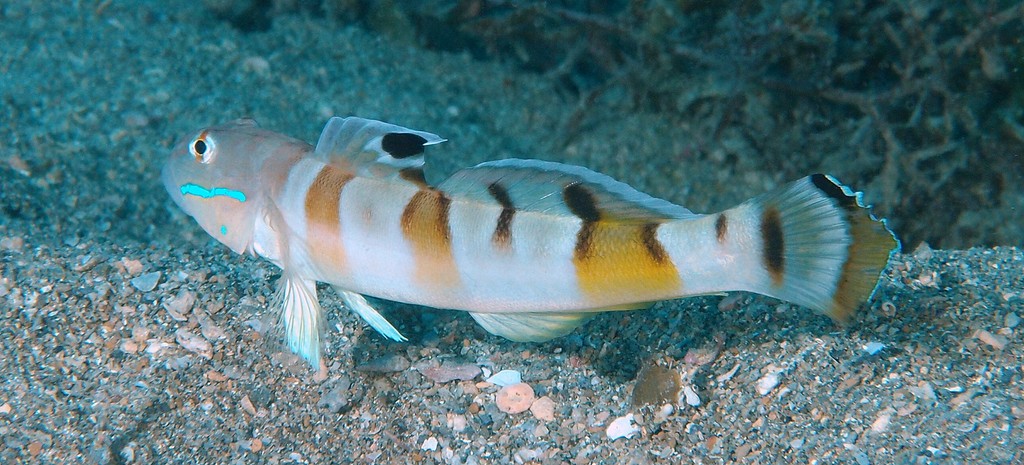VALENCIENNEA WARDII - (PLAYFAIR, 1867)
Actinopteri (Class) > Perciformes (Order) > Gobioidei (Suborder) > Gobiidae (Family) > Gobiinae (Subfamily) > Valenciennea (Genus)
Broad-barred sleeper-goby, Broadbarred glider goby, Broadbarred glidergoby, Ward's sleeper, Sasahaze,
Synonymes
Calleleotris wardi (Playfair, 1867)
Eleotris ellioti (Day, 1888)
Eleotris wardii (Playfair, 1867)
Eleotroides wardi (Playfair, 1867)
Valencienna wardii (Playfair, 1867)
Valenciennea nigromaculata (Herre, 1932)
Valenciennea phaeochalina (Tanaka, 1917)
Valenciennea wardi (Playfair, 1867)
-------------------------------------------------
Description
Dorsal spines (total): 6 - 7; Dorsal soft rays (total): 112; Anal spines: 1; Anal soft rays: 11 - 12. Characterized by pale grey to whitish body color with three brown bars on side; blue-white band below eye; first dorsal fin with ocellated black spot; presence of narrow dark brown saddles below anterior part of second dorsal fin and dorsally on caudal peduncle; brown with narrow blue margin, outer half of caudal fin; without filamentous dorsal spines; rounded caudal fin, equal or slightly shorter than head; longitudinal scale series 70-88; ctenoid body scales, becoming cycloid anteriorly in front of first dorsal fin; head or midline of nape without scales; side of nape with scales extending forward slightly anterior to opening of gill; pectoral fin base and prepelvic area usually scaled; depth of body 5.0-5.5 in SL. Max length : 15.0 cm SL. Depth range 5 - 88 m, usually 5 - 20 m.
Etymology
Valenciennea: From Achille Valenciennes 1794-1865; he worked with Duméril, Cuvier and Lacepède since 1815; malacologist, author of a "Histoire naturelle des poissons".
Original description: Eleotris wardii Playfair, 1867 - Locality type: Zanzibar, Tanzania, western Indian Ocean.
Distribution
Indo-Pacific: extremely rare, known from widely scattered localities in the Indian Ocean and western tropical Pacific. Red Sea, east Africa to Australia, New Caledonia north to Japan.
Biology
Found in sandy areas of shallow lagoon reefs. Inhabits coastal bays and inner reefs, usually on deep silty slopes from about 15 meters down. Occurs in pairs.
Broad-barred sleeper-goby, Broadbarred glider goby, Broadbarred glidergoby, Ward's sleeper, Sasahaze,
Synonymes
Calleleotris wardi (Playfair, 1867)
Eleotris ellioti (Day, 1888)
Eleotris wardii (Playfair, 1867)
Eleotroides wardi (Playfair, 1867)
Valencienna wardii (Playfair, 1867)
Valenciennea nigromaculata (Herre, 1932)
Valenciennea phaeochalina (Tanaka, 1917)
Valenciennea wardi (Playfair, 1867)
-------------------------------------------------
Description
Dorsal spines (total): 6 - 7; Dorsal soft rays (total): 112; Anal spines: 1; Anal soft rays: 11 - 12. Characterized by pale grey to whitish body color with three brown bars on side; blue-white band below eye; first dorsal fin with ocellated black spot; presence of narrow dark brown saddles below anterior part of second dorsal fin and dorsally on caudal peduncle; brown with narrow blue margin, outer half of caudal fin; without filamentous dorsal spines; rounded caudal fin, equal or slightly shorter than head; longitudinal scale series 70-88; ctenoid body scales, becoming cycloid anteriorly in front of first dorsal fin; head or midline of nape without scales; side of nape with scales extending forward slightly anterior to opening of gill; pectoral fin base and prepelvic area usually scaled; depth of body 5.0-5.5 in SL. Max length : 15.0 cm SL. Depth range 5 - 88 m, usually 5 - 20 m.
Etymology
Valenciennea: From Achille Valenciennes 1794-1865; he worked with Duméril, Cuvier and Lacepède since 1815; malacologist, author of a "Histoire naturelle des poissons".
Original description: Eleotris wardii Playfair, 1867 - Locality type: Zanzibar, Tanzania, western Indian Ocean.
Distribution
Indo-Pacific: extremely rare, known from widely scattered localities in the Indian Ocean and western tropical Pacific. Red Sea, east Africa to Australia, New Caledonia north to Japan.
Biology
Found in sandy areas of shallow lagoon reefs. Inhabits coastal bays and inner reefs, usually on deep silty slopes from about 15 meters down. Occurs in pairs.
